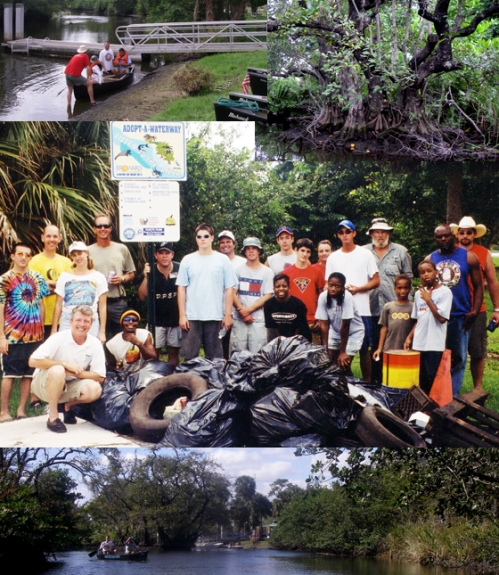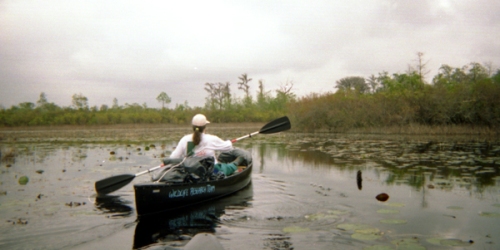As South Florida residents happily fling open windows to cool sunny days, swirling snowflakes will remind our family and friends it’s time to visit us lucky folks. Today’s post will help you guide your guests on a budget-friendly but memorable excursion. Miami deserves its reputation as a world-class destination, but it’s not always easy to show it off to its best advantage. The photo montage is to give you a taste of a Canoe View of the Magic City.
These photos were taken during excursions skirting the mangrove preserve on the west side, near the north end, of the barrier island called Key Biscayne. You access this paddling destination at Crandon Marina. You will have to supply your own canoes or kayaks; there is no rental facility at the marina. The boat ramp is open 24 hours a day, so you can paddle out whenever the mood strikes!
This location was the first saltwater canoeing Dr. Tom Kazo introduced me to, at the beginning of Wildlife Research Team in 1993. In those days, sad reminders of Hurricane Andrew’s force were everywhere, with many broken boats rudely shoved into the mangroves. We would often launch in the very early morning, but sometimes we would wait until the late afternoon and enjoy a beautiful sunset. On occasion, we could then turn the bow of our canoe to the east and watch the full moon rise over Key Biscayne. Sometimes, Tom and I would stay out until the wee hours of the morning, marveling at the bioluminescent creatures lighting up the waves, chilled by the mist rising from the water.
The old, gnarled red mangrove trees have withstood the brunt of many hurricanes. These stalwart protectors of the shoreline also fringe a championship golf course for part of the way. The peninsula jutting out into Biscayne Bay, known as West Point, is all dense mangrove habitat. As this is part of the treasure designated as the Biscayne Bay Aquatic Preserve, you and your guests may be delighted by sharks, sea turtles, dolphins both fish and mammal, manatee, rays, barracuda, tarpon, snook, glass minnow, pufferfish, needlefish, crabs, jellyfish, brown pelican, cormorant, anhinga, herons, egrets, magnificent frigatebird, and osprey, among many others.
I seriously recommend you check the weather and tides before venturing forth. When the tide is high, you will be able to paddle into cozy coves hidden behind and beneath the mature mangroves, which we made use of just the other day to escape the sun. If there is a strong wind from the east, northeast, or southeast, you can then be fairly sheltered in the lee of the island. I speak from white-knuckled experience: the shallow waters of Biscayne Bay can kick up big time! A strong west or southwest wind, combined with low tide? Pick another day, especially if you are leading a tour of guests unfamiliar with South Florida’s dramatically ephemeral weather.
To get there, take the Rickenbacker Causeway across to Key Biscayne; there’s a $1.75 toll for cars, and if you are towing a trailer, that will jump significantly, to over $10. My advice is to strap your canoe or kayak to the roof of your vehicle if possible! Your guests will certainly enjoy the view from the causeway; and as you pass through Virginia Key, don’t let them stop at the Miami Seaquarium! Point out University of Miami’s Rosenstiel School of Marine and Atmospheric Science just before you drive over Bear Cut; and then you are on Key Biscayne’s Crandon Boulevard. (NOTE: Bear Cut overpass is under construction, so traffic might be heavier.)
Keep a sharp eye to your right for Crandon Marina, as it’s close to the bridge and easy to shoot by. Make that right turn into the marina, and work your way past the parking lots and boats being launched or landed to the very end of the docks, on the left, or south end. The safest place to launch canoes and kayaks is as far away from the big stinky powered vessels and their often erratically driven tow vehicles as possible! Fee to launch a boat is $15, but canoes or kayaks are just $4.00. There are 24-hour automatic pay stations that accept exact change, or a credit or debit card; their public restrooms are about what you’d expect. “Nuff said.
Once you launch, keep to the left, where the water is shallow, so you can get away from powerboats. By following the fringing mangroves, you are most likely to see wildlife, which cannot be guaranteed; but the fabulous view of Miami’s ever-growing skyline is always ready and waiting for a photo! Just make sure everyone has stowed their camera equipment while entering or exiting their vessel, as that’s when you are most likely to drop it overboard! The sailboats moored between the marina and the small island/rookery make first-rate photo compositions. It’s a nice relaxing paddle along the curving shoreline of mangroves, exploring the nooks beneath the old mangroves and the tiny islands. You are likely to see stacks of glass minnows flashing beneath the surface, occasionally “skipping school” as they leap into the air. Eventually you will reach West Point, inhabited not by future officers of the US Army, but by seabirds, raccoons, and crabs. Straight out from there are sandbars and tidal flats where it’s possible to get out and slosh around with the wading birds, or even picnic, if conditions permit. It’s a stunning view, always. Look for the ivory gleam of Viscaya across the bay.
West Point can be a good turnaround, or you can follow the mangrove preserve until houses appear. At one time, President Richard Nixon’s waterfront home could have been seen further south, but it was razed years ago Although it would be quite a workout, it’s possible to paddle all the way down to the south end of Key Biscayne and the well-known Bill Baggs Cape Florida State Park. Key Biscayne offers many other great destinations: Cape Florida’s historic lighthouse, Crandon Park’s beach, Marjory Stoneman Douglas Biscayne Nature Center, Crandon Golf Key Biscayne, Crandon Park Tennis Center; and in the developed central area are hotels, resorts, shops and restaurants. Those may be for another day, though, unless the paddlers in your party are in great shape. Don’t forget the sunblock and a personal flotation device for every person in your group.
And remember, there are no two days alike on the water. Every trip will produce its own unique set of wonders, challenges and irreplaceable memories.
Thank you for your interest in Wildlife Research Team!
Info about Biscayne Bay Aquatic Preserve: http://www.dep.state.fl.us/coastal/sites/biscayne/









